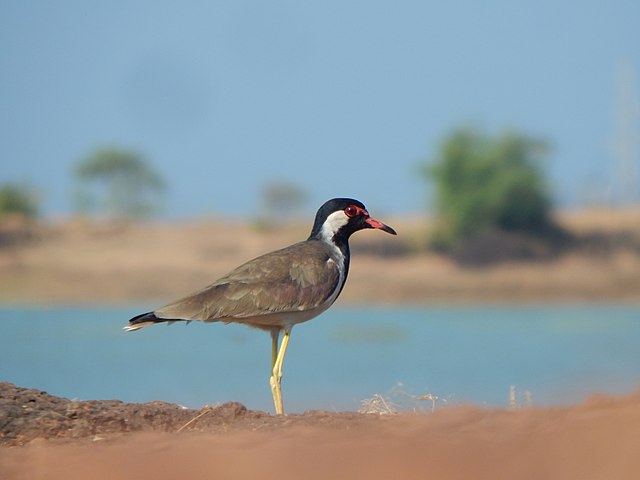Red-wattled lapwing
 |
| By Vinay bhat |
The local names are mainly onomatopoeic in origin and include titeeri (Hindi), titawi (Marathi), tittibha (Kannada), tateehar (Sindhi), titodi (Gujarati), hatatut (Kashmiri), balighora (Assamese), yennappa chitawa (Telugu), aal-kaati (Tamil, meaning "human indicator").
In parts of India, a local belief is that the bird sleeps on its back with the legs upwards and an associated Hindi metaphor Tithiri se asman thama jayega ("can the lapwing support the heavens?") is used to refer to persons undertaking tasks beyond their ability or strength.
In parts of Rajasthan it is believed that the laying of eggs by
the lapwing on high ground was an indication of good rains to come. The eggs are known to be collected by practitioners of folk medicine
Description
Red-wattled lapwings are large waders,
about 35 cm (14 in) long. The wings and back are light brown with a
purple to green sheen, but the head, a bib on the front and back of the
neck are black. Prominently white patch runs between these two colours,
from belly and tail, flanking the neck to the sides of crown. Short
tail is tipped black. A red fleshy wattle
in front of each eye, black-tipped red bill, and the long legs are
yellow. In flight, prominent white wing bars formed by the white on the
secondary coverts.
Race aigneri is slightly paler and larger than the nominate race
and is found in Turkey, Iran, Iraq, Afghanistan and the Indus valley.
The nominate race is found all over India. The Sri Lankan race lankae is smaller and dark while atronuchalis the race in north-eastern India and eastern Bangladesh has a white cheek surrounded by black.
It usually keeps in pairs or trios in well-watered open country,
ploughed fields, grazing land, and margins and dry beds of tanks and
puddles. They occasionally form large flocks, ranging from 26 to 200
birds.
It is also found in forest clearings around rain-filled depressions. It
runs about in short spurts and dips forward obliquely (with unflexed
legs) to pick up food in a typical plover manner.They are said to feed at night being especially active around the full moon.
Is uncannily and ceaselessly vigilant, day or night, and is the first
to detect intrusions and raise an alarm, and was therefore considered a
nuisance by hunters. Flight rather slow, with deliberate flaps, but
capable of remarkable agility when defending nest or being hunted by a
hawk.
Diet
The diet of the lapwing includes a range of insects, snails
and other invertebrates, mostly picked from the ground. They may also
feed on some grains. They feed mainly during the day but they may also
feed at night. They may sometimes make use of the legs to disturb insect
prey from soft soil.
Breeding Season
The breeding season is mainly March to August. The courtship involves
the male puffing its feathers and pointing its beak upwards. The male
then shuffles around the female. Several males may display to females
and they may be close together. The eggs are laid in a ground scrape or depression sometimes fringed with pebbles, goat or hare droppings. About 3–4 black-blotched buff eggs shaped a bit like a peg-top,
42x30 mm on average. Nests are difficult to find since the eggs are
cryptically coloured and usually matches the ground pattern.
Courtesy : Wikipedia

TFS Such information of birds.
ReplyDelete